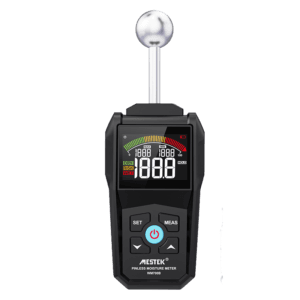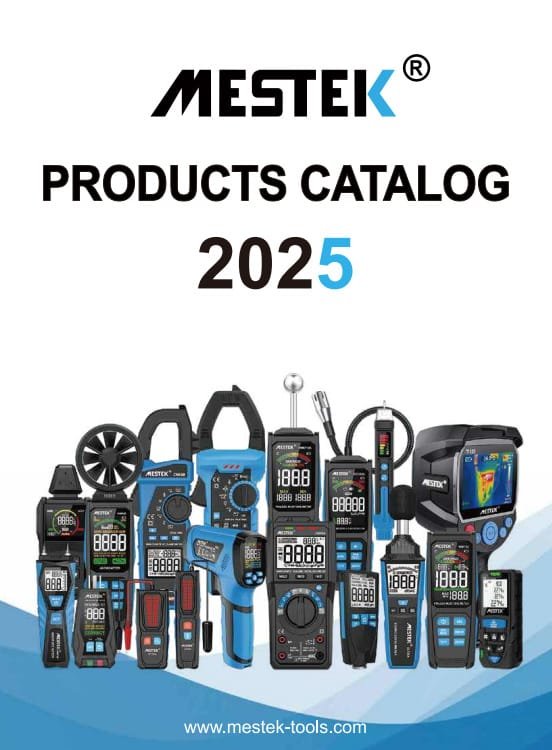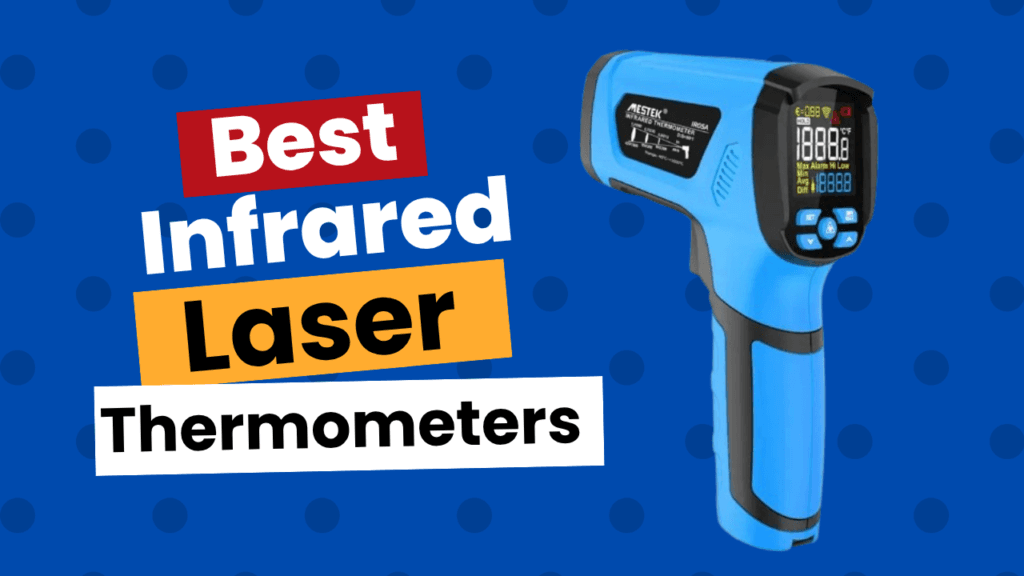
Infrared laser thermometers make checking temperatures fast, easy and contactless. Whether you’re measuring heat from engines, ovens, grills or electrical systems, these tools give quick results without touching the surface. In 2025, both pros and DIYers will have access to accurate and affordable models. Some thermometers like the high-end IR05A, have advanced features like long range targeting and wide temperature ranges. But using them correctly is key; settings like emissivity and outside elements like steam or dust can affect accuracy.
This article reviews the 7 best infrared laser thermometers available in 2025, comparing features, temperature ranges and value for money. Our list highlights top performers based on accuracy, range, ease of use and value for money so you can find the right one for your needs. Let’s explore the tools that are heating up the market this year.
What are Infrared Thermometers?
An infrared thermometer, often abbreviated as an IR thermometer, is a device that measures the temperature of an object or surface from a distance, without the need to touch it. This technology works by detecting the infrared radiation (a form of electromagnetic radiation) emitted by all objects based on their temperature. By capturing this radiation the infrared thermometer can calculate and display a temperature reading in seconds.
Infrared radiation was discovered in the early 1800s. The first patent for an infrared thermometer was in 1901, but people didn’t use them much until the 1930s. By the early 2000s, they were increasingly found in homes, hospitals, and businesses.
How Do They Work?
Infrared thermometers work on the principle of Planck’s law of blackbody radiation which states that all objects with a temperature above absolute zero emit infrared energy. The device uses a lens to focus the infrared light coming from an object onto a detector, usually a thermopile. The detector converts this energy into an electrical signal which is then processed and displayed on the screen.
Unlike traditional contact thermometers, IR thermometers are non-invasive and fast, making them very useful in many situations.
Applications of Infrared Thermometers
Because they are non-contact, IR thermometers are used in many sectors:
- Medical: To quickly measure body temperature, especially during outbreaks.
- Industrial: Monitor machinery, electrical systems or manufacturing lines for overheating components.
- Food Service: To ensure safe cooking and storage temperatures in kitchens and restaurants.
- HVAC: To check temperature differences in heating and cooling systems.
- Automotive: To diagnose engine or brake system temperatures.
7 Best Infrared Laser Thermometers
Now that we know about infrared thermometers, let’s look at the top models available in 2025. These seven infrared laser thermometers are top performers, versatile and value for money, each with unique features for different applications.
1) Fluke 62 MAX Plus Infrared Thermometer

The Fluke 62 MAX Plus Infrared Thermometer is one of the toughest and most reliable tools in its class. It can handle a 3-meter drop and has an IP54 rating, so it’s protected against dust and water, great for tough work environments. It measures temperatures from -30°C to 650°C for many applications.
Fluke 62 MAX Plus has ±1.0°C or ±1.0% reading accuracy, whichever is greater. It features a 12:1 distance-to-spot ratio for precise measurements from far away and uses dual lasers to show exactly where you’re measuring. The emissivity is adjustable from 0.10 to 1.00 for accurate readings on different surfaces, whether you’re measuring electrical panels, machines, or HVAC systems.
The Fluke 62 MAX Plus also has high and low alarms that alert you when readings go beyond your set limits and display minimum, maximum, average and difference values. It runs on a single AA battery for up to 8 hours of continuous use with laser and backlight on. It is a practical, easy to use and reliable tool for professionals who need accuracy and durability.
2) MESTEK IR05A Industrial Infrared Thermometer
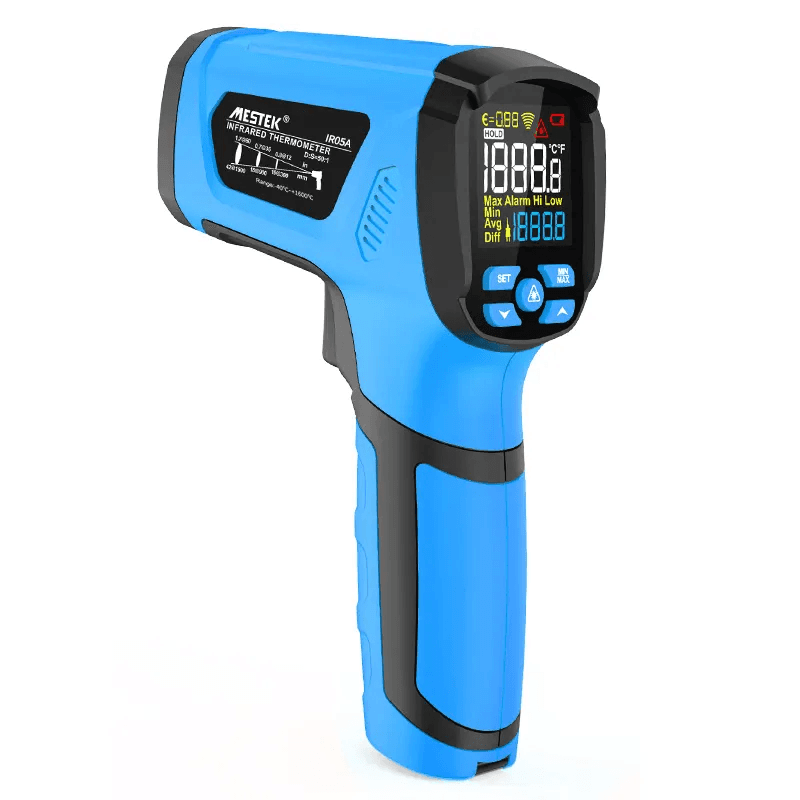
The MESTEK IR05A is an industrial infrared thermometer for extreme temperature measurement. It can measure temperatures ranging from -40°F to 2912°F (-40°C to 1600°C), making it ideal for high-temperature applications. With a 50:1 distance-to-spot ratio, you can take accurate readings from a safe distance.
It has a 0.5-second response time and an adjustable emissivity range from 0.10 to 1.00 for accurate readings on different surfaces. The color LCD display is easy to read even in dark areas. It has multiple measurement modes (MIN, MAX, AVG, DIF) and customizable high/low temperature alarms to detect abnormal conditions quickly.This is useful in professional settings like HVAC, electrical and mechanical maintenance, or high temperature environments like kilns and metal casting. It comes with two AA batteries and has auto power-off and low battery indicator to save energy. For more info or to check similar products, visit MESTEK’s website.
3) Klein Tools IR10 Dual Laser Infrared Thermometer

The Klein Tools IR10 Dual Laser Infrared Thermometer is a high performance tool for professionals. A 20:1 distance-to-spot ratio provides more accurate measurements from farther away compared to standard models. Measures a wide temperature range from -40°F to 1200°F for many applications. Dual-targeting lasers accurately define the specific measurement area.
Adjustable emissivity (0.1 to 1.0) allows accurate readings on various surfaces. Quick readings with less than 150 milliseconds response time. Compatible with K-Type probe to measure temperatures of air, gas or liquids. IR10 has minimum, maximum, difference and average temperature readings for analysis.
The unit has adjustable upper and lower limits and built-in audio and visual alarms. Soft-touch, over-molded housing can survive 9.8 feet (3 meters) drops. IP54 rated for dust and water protection. 9V battery and comes with a custom pouch and K-Type probe. It is a great value for professionals who need a reliable and versatile thermometer.
4) Estink Infrared Thermometer

The Estink ES6530B Infrared Thermometer is a great performer and value. It uses a 12-point circular laser targeting system to define the measurement area for better accuracy. It measures temperatures from -50°C to 550°C (-58°F to 1022°F) for many applications, including cooking, HVAC maintenance, and automotive diagnostics.
The thermometer features a 12:1 distance-to-spot ratio and ±1.5% accuracy for precise and reliable readings. 0.5 seconds response time for professional and home use. The visual alarm system displays a red light when the temperature exceeds the set limit.
The backlit display makes it easy to read in low light and switches between Celsius and Fahrenheit units. The anti-skid design improves grip and stability during use, reduces accidents, and ensures safe handling. Overall, it is a reliable and user-centric tool for precision and practicality.
5) SOVARCATE Infrared Thermometer

SOVARCATE HS980E infrared thermometer is a reliable and well built tool with great performance. It provides accurate temperature readings for hot and cold surfaces, especially hot items like cooking oil. It can measure temperatures from -58°F to 1112°F, making it ideal for various applications. The 12:1 distance-to-spot ratio ensures accurate readings from a safe distance.
A 13-dot laser pattern with a center dot for aiming and 12 dots around it to show the measurement area. The emissivity range is adjustable from 0.1 to 1.0 for accurate readings on different surfaces. The 1.37-inch color LCD screen is bright and easily readable from any viewing angle.
Textured hand grip with finger indents for secure hold even with wet hands. Mode to adjust emissivity, display maximum temperature reading, and a temperature alarm that beeps loudly when a set temperature is reached. Overall, a practical and easy to use thermometer for home and professional use.
6) BTMETER BT-1500

The BTMETER BT-1500 is a high-performance infrared thermometer designed for professional use. It features a powerful 30:1 distance-to-spot ratio, allowing you to accurately measure temperatures from a safe distance, especially useful when dealing with hot surfaces. It can measure a wide temperature range from -50°C to 1500°C with a reliable accuracy of ±2%.
The thermometer has two lasers that create a circle, making it easy to aim exactly where you want. It also gives quick results in just 250 milliseconds. The BT-1500 displays minimum, maximum, and average temperatures, and you can set custom alarms for different temperature limits.
Its backlit LCD screen and built-in flashlight make it easy to see readings in dark or low-light areas. The thermometer comes ready to use with a 9V battery included. It’s also certified for safety and quality with FDA, FCC, and CE approvals, and it features a Class II laser with an optical power of less than 0.5 mW. Overall, the BT-1500 is a durable, accurate, and user-friendly tool for both industrial and everyday use.
7) SOVARCATE AS530

The SOVARCATE AS530 is an easy to use and safe infrared thermometer to measure surface temperatures without contact. Advanced infrared technology quickly checks hot or cold surfaces, perfect for cooking, car repairs or home maintenance. Measures -32°C to 550°C (-26°F to 1022°F). Switch between Celsius and Fahrenheit easily.
Built-in laser for precise aiming. 12:1 distance-to-spot ratio, 0.95 fixed emissivity, ±2% accuracy and 500 ms response time. Large backlit display for easy reading in low light. Auto shut-off to save battery and data hold to keep your reading visible.
Made from durable ABS plastic, comfortable and sturdy grip. AS530 comes with a free meat thermometer with a stainless steel probe that measures internal temperatures from -50°C to 300°C (-58°F to 572°F). Great gift for anyone who loves to cook or do home projects.
Important features to consider
When choosing an infrared thermometer, you need to understand the technical specifications that matter. These devices vary greatly and knowing what features are important for your needs will help you make a better purchase decision.
1) Accuracy
Accuracy indicates how closely the thermometer’s reading matches the actual temperature of the object. Most standard models are ±2°C or ±4°F. Professional models are tighter. However, several factors can affect accuracy: steam, dust or smoke can interfere with infrared detection.
A thermometer needs about 20 minutes to acclimate when moved between environments with different temperatures. Shiny surfaces and dirty lenses can also give inaccurate readings. Lab-grade thermometers are ±0.3°C accurate but real-world results can vary greatly, sometimes under-report or over-report temperatures.
2) Distance-to-Spot Ratio (D:S)
Distance-to-Spot Ratio (D:S) is how large an area a thermometer measures at a certain distance. A 12:1 distance-to-spot ratio means the thermometer measures a 1-inch area when it’s held 12 inches away from the object. Higher ratios like 30:1 or 50:1 allow you to measure smaller targets from farther distances, which is good for safety or precision.
It’s a common myth that the laser beam indicates the exact measured area; the measurement spot is always wider. For accurate readings, make sure the target is at least twice as large as the measurement spot. Industrial-grade models like IR-PRO-100 with a 100:1 ratio are perfect for high-heat applications from a distance.
3) Fixed vs. Adjustable Emissivity
Emissivity measures how well a material emits infrared energy and ranges from slightly above 0 to nearly 1. Materials with high emissivity (like human skin or food) are easier to measure accurately. Fixed emissivity thermometers are preset (usually 0.95), great for most organic or painted surfaces.
However, shiny or metallic materials reflect IR energy, making fixed-emissivity readings unreliable. Adjustable emissivity thermometers solve this issue by allowing users to set the emissivity to match different surface types. They are essential for professionals dealing with varied materials and surfaces.
4) Dual-Laser Technology
Dual-laser thermometers have two laser points to mark the measurement area’s boundaries. Unlike single-laser models that point only to the center, dual-laser systems show the actual size of the measured spot. This is especially helpful when targeting small or specific areas from a distance.
For example, at 30 inches, the lasers may converge to show a 1-inch diameter spot. This feature removes the guesswork and ensures accurate targeting. Many advanced models also come with backlit displays, temperature alarms and tripod mounts, perfect for industrial, HVAC and culinary applications.
FAQs
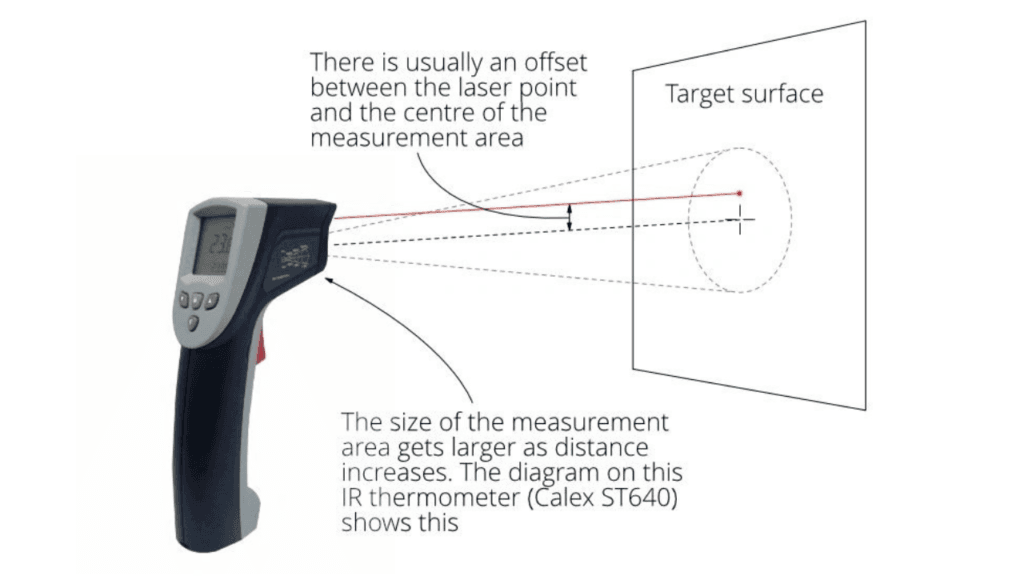
Can infrared thermometers see through glass or water?
No, infrared thermometers cannot measure temperatures through glass or water. Despite their advanced technology, these devices only measure the surface temperature of these materials rather than what lies beyond them. When you point an infrared thermometer at an object underwater or behind glass, you’ll get a reading for the surface temperature of the water or glass itself, not the target object.
How do I clean and maintain my infrared thermometer?
First and foremost, keep your infrared thermometer free of dirt, dust, moisture, fog, smoke and debris for accurate readings. Clean your device immediately after exposure to dirty, dusty, smoky, or humid conditions. For routine maintenance:
- Clean with a soft cloth or cotton swab moistened with water or medical alcohol; avoid using soap or harsh chemicals.
- Wipe the lens first, then the body of the thermometer
- Make sure the lens is fully dry before using the thermometer.
Avoid putting any part of the thermometer into water. Store your device between 40°F and 149°F (4-65°C) to protect it from extreme temperatures.
What affects the accuracy of infrared thermometers?
Several factors can affect infrared thermometer readings:
- Environmental conditions: Steam, dust, smoke or fog between the thermometer and target can deflect infrared energy
- Angle of measurement: Hold the thermometer at 45° angle and aim correctly
- Reflective surfaces: Shiny metal objects and glossy packaging can affect accuracy
- Emissivity settings: Incorrect settings for the material being measured can cause significant reading errors
- Temperature fluctuations: Rapid ambient temperature changes can affect readings
- Dirty or scratched lens: Reduces the device’s capacity to detect infrared energy accurately.
What is the response time of infrared thermometers?
Infrared thermometers have a response time of 0.5 seconds. This fast measurement capability makes them ideal for applications that require immediate readings.
Conclusion
Choosing the right infrared laser thermometer depends on what you need it for. Whether you’re checking food, fixing HVAC systems or working in an industrial setting, accuracy, temperature range and ease of use matter. Some models, like MESTEK IR05A, can handle extreme temperatures, while others are for everyday use. Knowing how to use and maintain your device will give you the most reliable results. With the right thermometer, you can work safely and efficiently without contact.
Looking for an infrared thermometer? Explore MESTEK’s full range of professional tools at MESTEK Instruments and find the perfect fit for your needs today!
